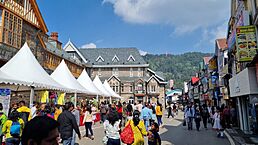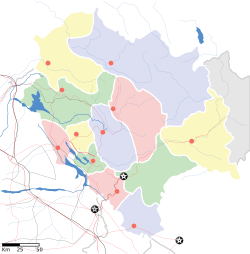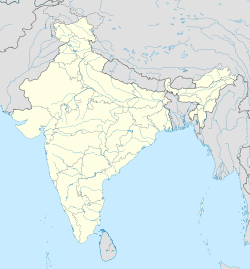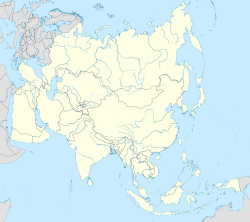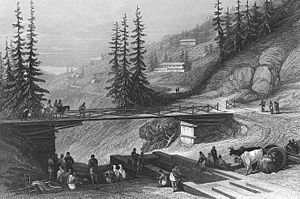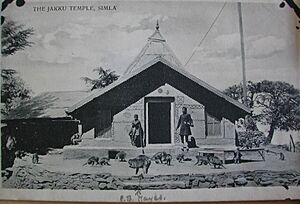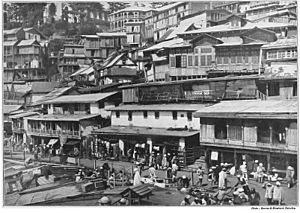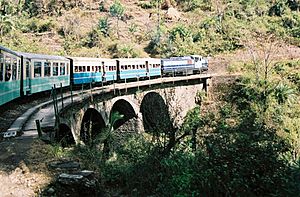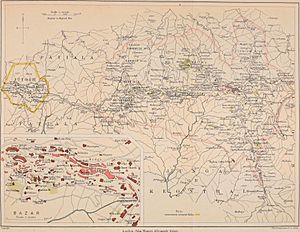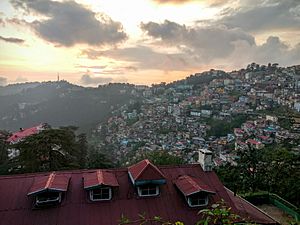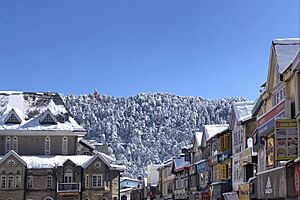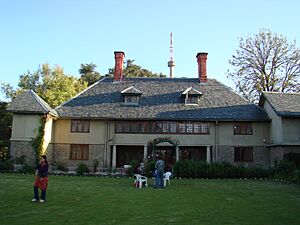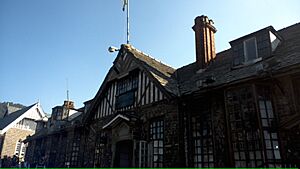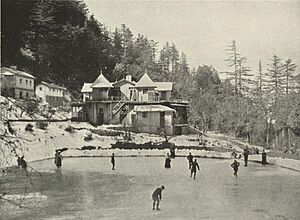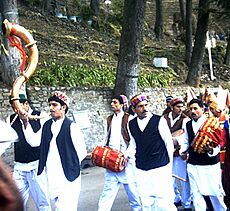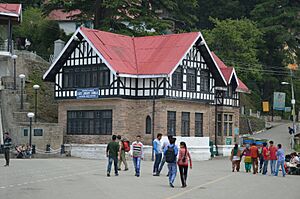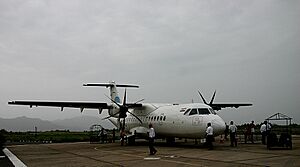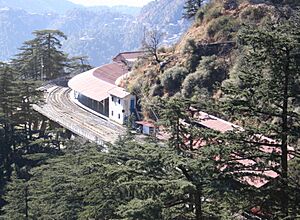Shimla facts for kids
Quick facts for kids
Shimla
Simla
|
|
|---|---|
|
Clockwise From Top:- Shimla's skyline, Rashtrapati Niwas, Annadale, Longwood, Gaiety Theatre, cityscape of Shimla, Christ Church, Kalka–Shimla Railway
|
|
| Nickname(s):
Queen of Hills
|
|
| Country | |
| State | |
| District | Shimla |
| Named for | Goddess Shyamala |
| Government | |
| • Type | Municipal Corporation |
| • Body | Shimla Municipal Corporation |
| Area | |
| • State capital | 35.34 km2 (13.64 sq mi) |
| Elevation | 2,276 m (7,467 ft) |
| Population
(2011)
|
|
| • State capital | 169,578 |
| • Rank | 1 (in HP) |
| • Density | 4,798.5/km2 (12,428.0/sq mi) |
| • Metro | 171,640 |
| Languages | |
| • Official | Hindi |
| • Additional official | Sanskrit, English |
| Time zone | UTC+5:30 (IST) |
| PIN |
171 001
|
| Telephone code | 91 177 XXX XXXX |
| ISO 3166 code | ISO 3166-2 |
| Vehicle registration | HP-03, HP-06, HP-08, HP-09, HP-10, HP-51, HP-62, HP-63, HP-77, HP-92, HP-95 |
| UN/LOCODE | IN SLV |
| Climate | Cwb |
| Precipitation | 1,577 mm (62 in) |
| Avg. annual temperature | 17 °C (63 °F) |
| Avg. summer temperature | 22 °C (72 °F) |
| Avg. winter temperature | 6–7 °C (43–45 °F) |
Shimla (also known as Simla) is the capital city of Himachal Pradesh, a state in northern India. It is the largest city in the state. In 1864, Shimla became the summer capital of British India, a time when India was ruled by the British.
Before 1815, Shimla was just a few small villages. The cool weather made the British want to build a city here, deep in the Himalayas. As the summer capital, Shimla hosted many important meetings. After India became independent in 1947, Shimla first became the capital of East Punjab. Later, it became the capital of Himachal Pradesh.
Shimla has many old buildings with unique designs, like Tudorbethan and neo-Gothic styles. These buildings, along with temples, churches, and beautiful nature, attract many tourists. Some popular spots include the Jakhu Temple, Viceregal Lodge, Christ Church, Mall Road, and The Ridge. The Kalka–Shimla Railway, a UNESCO World Heritage Site, is also a big draw for visitors. Shimla is also known for its mountain biking race, MTB Himalaya, and has the largest natural ice skating rink in South Asia. Besides tourism, Shimla is an important place for education, with several colleges and research centers.
Contents
What's in a Name?
One idea is that "Shimla" comes from Shyamalaya, which means 'blue house'. This was a blue slate house on Jakhu Hill, built by a holy person called a fakir.
Another idea is that the city got its name from Shamli or Shyamala. This means 'blue lady' and refers to the goddess Kali. People believe there was a temple for goddess Shamli near Jakhu hillside. During the British rule, the statue of the goddess was moved to the famous Kali Bari Temple.
In 2018, the state government thought about changing the city's name to Shyamala. But people didn't like the idea, so the plan was dropped.
A Look Back in Time
Most of what is now Shimla was a thick forest in the 1700s. Only the Jakhu Temple and a few houses were there. The area was named 'Shimla' after the Hindu goddess Shyamala Devi, a form of Kali.
In 1806, Bhimsen Thapa from Nepal took over the area. The British East India Company gained control after the Anglo-Nepalese War (1814–16). In 1819, a British officer named Lieutenant Ross built a wooden cottage in Shimla. Three years later, Charles Pratt Kennedy built the first strong house, Kennedy Cottage, in 1822.
The British loved the cool, Britain-like weather. Many officers started spending their summers here. By 1826, some stayed for their whole vacation. In 1827, William Amherst, the Governor-General, visited. The town grew quickly, from 30 houses in 1830 to 1,141 in 1881.
In 1832, Shimla hosted its first political meeting. Lord William Bentinck, the Governor-General, met with representatives of Maharaja Ranjit Singh. Shimla became a popular hill station for parties and social events. Schools for wealthy families were also built nearby.
The foundation for the Christ Church was laid in 1844. Roads were made wider, and a long tunnel for the Hindustan-Tibet road was built in 1851–52. The 1857 uprising caused some worry, but Shimla was mostly safe from the rebellion.
In 1863, John Lawrence, the Viceroy of India, decided to make Shimla the summer capital of British India. This meant moving the government twice a year, over 1,000 miles, which was very difficult. The "Upper Bazaar," where many Indian people lived, was cleared after a fire. This area became the center of the European town, with a town hall, library, and theater.
Shimla also became the headquarters for the British Indian Army. Many British families joined their husbands here to escape the heat of the plains. Shimla became known as a very expensive and desirable place to live. British soldiers and officials came here every year to avoid the summer heat.
The Simla Convention was signed here in 1913–1914. This treaty was about the status of Tibet. It also proposed the McMahon Line, which is now the border between China and India. Shimla was also where talks were held to plan India's independence, known as the Simla Conference. These talks did not succeed.
From 1942 to 1945, Shimla was the capital city for British Burma (now Myanmar) during World War II.
The Kalka–Shimla Railway opened in 1903. It made Shimla much easier to reach and more popular. This railway has over 806 bridges and 103 tunnels. It was called the "British Jewel of the Orient" because it was such an amazing engineering feat. In 2008, it became a UNESCO World Heritage Site.
After India became independent, Shimla was briefly the capital of East Punjab. When the state of Himachal Pradesh was formed in 1971, Shimla became its capital. In 1972, the Simla Agreement was signed here by the leaders of India and Pakistan. This agreement helped Pakistan recognize Bangladesh as a country.
Many buildings from the British era still stand in Shimla today. These include the former Viceregal Lodge, Christ Church, and the Gaiety Theatre. They remind us of British rule in India.
Where is Shimla?
Shimla is located in the southwestern part of the Himalayas. It sits at an average height of about 2,206 meters (7,238 feet) above mean sea level (the average height of the ocean). The city stretches for almost 9.2 kilometers (5.7 miles) from east to west along a ridge.
Shimla is in an area with a high risk of earthquakes. Old buildings and a growing population make this a serious concern. There are no large bodies of water near the main city. The closest river, the Sutlej, is about 21 kilometers (13 miles) away.
The forests in and around Shimla have Pine, Deodar, Oak, and Rhododendron trees. However, more tourists visiting each year without enough facilities is causing harm to the environment. This is making Shimla less appealing as a place for ecotourism. Also, landslides often happen after heavy rains, which is a growing worry.
Shimla is about 88 kilometers (55 miles) northeast of Kalka and 116 kilometers (72 miles) northeast of Chandigarh. It is about 350 kilometers (219 miles) northeast of Delhi, India's capital.
Interestingly, if water falls on the northern side of the Ridge ground in Shimla, it flows to the Arabian Sea through the Sutlej River. But if it falls on the southern side, it goes to the Bay of Bengal through the Yamuna River.
Shimla's Seven Hills
Shimla was built on seven main hills: Inverarm Hill, Observatory Hill, Prospect Hill, Summer Hill, Bantony Hill, Elysium Hill, and Jakhu Hill. The highest point in Shimla is Jakhu Hill, which is 2,454 meters (8,051 feet) high. Today, the city has grown beyond these original seven hills.
Shimla's Weather
Shimla has a subtropical highland climate. This means it's usually cool in winter and moderately warm in summer.
In summer, the average temperature is between 16 and 25 degrees Celsius (61 and 77 degrees Fahrenheit). In winter, it's between 3 and 11 degrees Celsius (37 and 52 degrees Fahrenheit). The amount of rain changes throughout the year. It's lowest in November and highest in August.
The city gets about 1,487 millimeters (58.5 inches) of rain each year. Snowfall usually happens in January or early February. In recent years, the most snow recorded was 38.6 centimeters (15.2 inches) on January 18, 2013. Over two days in January 2013, the town received 63.6 centimeters (25 inches) of snow.
In August 2023, heavy rains caused major landslides in Shimla, killing many people. This was linked to climate change.
How Shimla Makes Money
Most jobs in Shimla are in government and tourism. The education sector and processing of garden produce also provide many jobs. A special center helps connect people looking for jobs with employers.
Shimla is also a healthcare hub. It has a medical college and four main hospitals. The city plans to become a popular place for health tourism. Many state government offices are also located here.
The hotel business is a big source of money for Shimla. The city has about 6,500 hotels, including luxury ones like The Oberoi Cecil and Peterhoff. Shimla is known for having some of the highest-rated hotels in India.
Shimla has many schools and colleges. These include Himachal Pradesh University and the Indian Institute of Advanced Study. Many students from all over India choose to study in Shimla because of its good climate and reputation as the "Queen of Hill Stations." This helps the local economy.
The government is trying to grow the technology and IT sector in Shimla. While not many big companies have moved in yet, there are many new startups. Shimla also has several call centers.
Running the City
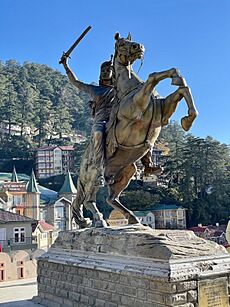
The Shimla Municipal Corporation (SMC) manages the city. It was started in 1851. The SMC has 41 elected members called councillors. Three more are chosen by the government. One-third of the seats are saved for women. Elections happen every five years, and the mayor is chosen by the councillors.
The main leader of the corporation is the Commissioner, appointed by the state government. The main political parties are the Bharatiya Janata Party and Indian National Congress. The Communist Party of India (Marxist) is also becoming more important.
Shimla sends one representative to the state assembly and one to the national parliament. The police, fire department, and other services keep law and order in the city. There are five police stations and three fire stations.
People of Shimla
Population Facts
In 2011, Shimla city had about 169,578 people living in an area of 35.34 square kilometers. There were more males (93,152) than females (76,426). The city's literacy rate (people who can read and write) was very high, at 93.63%.
The city has grown a lot over time. About 55% of the people are between 16 and 45 years old. Another 28% are younger than 15. The number of girls compared to boys is a concern. In 2001, there were 930 girls for every 1,000 boys, which is lower than the state average.
The number of people without jobs has gone down. This is because of new industries, more service jobs, and better education.
Languages Spoken
Hindi is the main language spoken in Shimla and is used for official purposes. English is also spoken by many people and is the second official language. Many local people speak Pahari languages. Punjabi language is also common among people who moved here from Punjab after India was divided in 1947.
Religions
| Religion in Shimla Town (2011) | ||||
|---|---|---|---|---|
| Percent | ||||
| Hinduism | 93.5% | |||
| Islam | 2.29% | |||
| Sikhism | 1.95% | |||
| Buddhism | 1.33% | |||
| Christianity | 0.62% | |||
| Jainism | 0.10% | |||
According to the 2011 census, most people in Shimla are Hindu (93.5%). Other religions include Islam (2.29%), Sikhism (1.95%), Buddhism (1.33%), Christianity (0.62%), and Jainism (0.10%).
Shimla's Culture
People from Shimla are sometimes called Shimlaites. Many different festivals are celebrated here. The annual Shimla Summer Festival happens on the Ridge when many tourists visit. It features performances by popular singers. A winter carnival is also held from Christmas to New Year's.
Shimla has many interesting places to visit. The Mall and the Ridge are popular spots in the city center. Many old buildings have kept their original 'Tudorbethan' style. The former Viceregal Lodge, now the Indian Institute of Advanced Study, is one example. The State Museum has a collection of local paintings, jewelry, and clothes.
Lakkar Bazaar, a market near the Ridge, sells wooden souvenirs and crafts. Tatta Pani, about 55 kilometers (34 miles) away, has hot sulphur springs believed to have healing powers. Shimla also has South Asia's only natural ice skating rink. Competitions are held here, and a carnival takes place every January. However, due to global warming, there are fewer ice skating sessions each winter.
Shimla has many temples, attracting visitors from nearby areas. The Kali Bari temple is dedicated to the goddess Kali. Jakhoo Temple, for the god Hanuman, is at the highest point in Shimla. Sankat Mochan, another Hanuman temple, is famous for its many monkeys. The nearby Tara Devi temple is a place for rituals. There is also a Gurudwara and Christ Church.
Shimla's arts and crafts are popular with tourists. These include beautiful jewelry, embroidered shawls, leather items, and wooden carvings. The wood from pine and deodar trees is used in many buildings and crafts.
Carpet making is also a big attraction, with different patterns and designs. Wool is used to make blankets and rugs. Embroidery can be found on handkerchiefs, hand fans, gloves, and caps. Leather crafts include shoes, slippers, and belts.
Shimla has the largest natural ice skating rink in South Asia. The ice skating season usually runs from December to February. The city also has sports venues like the Indira Gandhi Rajya Khel Parisar and a golf course at Annadale. Kufri, about 19 kilometers (12 miles) away, is a ski resort in winter.
Learning in Shimla
Shimla has many schools, including some from the British era. Popular schools include Bishop Cotton School, Convent of Jesus and Mary (Chelsea), and St. Edward's School. Bishop Cotton and St. Edward's are for boys, while Loreto Convent and Convent of Jesus and Mary are for girls.
For higher education, there's Indira Gandhi Medical College and St. Bede's, a college for girls. Himachal Pradesh University is also in Shimla. The Indian Institute of Advanced Study, located in the former Viceregal Lodge, is a research center for humanities and sciences.
Shimla has two state libraries with over 47,000 old books. Other research centers include the Central Potato Research Institute.
Fun Places to Visit
- The Mall is Shimla's main shopping street. It has restaurants, banks, and tourist offices.
- The Ridge is a big open space next to the Mall Road. All the city's cultural events happen here. Christ Church, the second oldest church in Northern India, is on the Ridge.
- Jakhoo Hill is the highest point in Shimla, at 8,000 feet. It offers great views of the city and the Himalayas. At the top is an old temple dedicated to Hanuman. A 108-foot statue of Hanuman stands here, one of the tallest statues at such a high altitude. There's also a ropeway connecting Jakhoo temple to the Ridge.
- Kali Bari is a temple for Goddess Kali's form, Shyamala, after whom Shimla is named. From the temple, you can see places like Annadale and the Shimla Railway Station.
- Annadale was once Shimla's racecourse. It's now used by the Indian Army. It has the Army Heritage Museum, a golf course, and a helipad. Important visitors to Shimla often arrive here.
- Indian Institute of Advanced Studies is an educational center located in the former Viceregal Lodge.
- Himachal Pradesh State Museum, opened in 1974, protects the state's cultural treasures. It has paintings, sculptures, and traditional clothes.
- Summer Hill is on the Shimla-Kalka railway line. Mahatma Gandhi stayed here during his visits. Himachal Pradesh University is located here.
- Sankat Mochan Temple is a Hindu temple for Hanuman, located on the Shimla-Chandigarh highway.
- Tara Devi Temple is 11 kilometers (7 miles) from the bus stand. It's on top of a hill and dedicated to the goddess of stars.
- Kufri is near Shimla. It hosts a winter sports festival in February, with activities like skiing.
- Himalayan Nature Park is just outside the city.
- Chharabra is near Kufri, known for its natural beauty.
- Mashobra is also near Shimla, with Craignano Park as a popular spot.
Getting Around Shimla
In Shimla, people travel by bus or private cars. Buses run often on the circular road around the city center. As Shimla grows, transport services are expanding. Tourist taxis are available for trips outside the city. Many locals prefer to walk around the city. Private cars are not allowed on the Mall, Ridge, and nearby markets. Because of narrow roads and steep slopes, you won't see many auto rickshaws like in other Indian cities.
Roads
Shimla is well-connected by roads to major cities in northern India and towns within Himachal Pradesh. National Highway 5 links Shimla to Chandigarh. This road is being made wider as part of the Shimla-Chandigarh Expressway project.

Air Travel
Shimla Airport is at Jubbarhatti, 23 kilometers (14 miles) from the city. There are regular flights to Delhi. The closest major airport is Shaheed Bhagat Singh International Airport in Chandigarh, about 116 kilometers (72 miles) away.
Rail Travel
The beautiful Kalka Shimla Railway is a narrow gauge track. It's in the Guinness Book of Records for having the steepest climb in altitude over 96 kilometers (60 miles). Kalka, at the end of the plains railway, has daily trains to big Indian cities. Shimla has three railway stations: Shimla (the main one), Summer Hill, and Totu. This railway was built to connect Shimla, the summer capital of British India, to the rest of the Indian rail system.
In 2007, the government of Himachal Pradesh called the railway a heritage property. In 2008, the Kalka–Shimla Railway became a World Heritage Site by UNESCO.
Media and Communication
State-owned All India Radio and Reliance Broadcast's 95.0 BIG FM have local radio stations in Shimla. They broadcast many programs for the public. The national TV broadcaster Doordarshan also has channels like DD Shimla, DD National, and DD Sports. There are also private FM radio channels.
Amar Ujala, Punjab Kesari, and Dainik Bhaskar are popular Hindi newspapers. The Tribune, The Times of India, Hindustan Times, and Indian Express are popular English newspapers in the city.
Famous People from Shimla
- Charlie Chauhan, TV actress
- Rubina Dilaik, TV actress
- Guy Gibson, WWII pilot, VC winner
- O.C. Handa, historian
- S.R. Harnot, writer
- Raaja Bhasin, writer and historian
- John Hunt, British army officer and mountaineer
- Celina Jaitly, Bollywood actress
- Shriniwas Joshi, writer
- M. M. Kaye, novelist
- Anupam Kher, Bollywood actor
- Rudyard Kipling, English author
- Ram Kumar, painter
- Ankit Love, politician
- Meghna Pant, author
- Motilal Rajvansh, Bollywood actor
- Priya Rajvansh, actress
- Sheila Ramani, Miss Shimla
- Bruce Seton, British soldier and actor
- Idries Shah, writer
- Anand Sharma, former Union Minister
- Chetan Singh, historian
- Pratibha Singh, politician
- Shakti Singh, Bollywood actor
- Asmita Sood, TV actress
- Dhan Singh Thapa, Indian army officer
- Nirmal Verma, Hindi writer
- Sushma Verma, Indian cricketer
- Preity Zinta, Bollywood actress
Sister Cities
Shimla has a "sister city" relationship with:
 Carbondale, Illinois, United States
Carbondale, Illinois, United States
See also
 In Spanish: Shimla para niños
In Spanish: Shimla para niños









